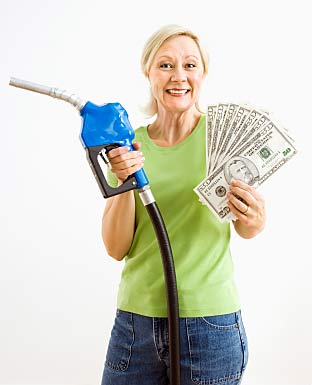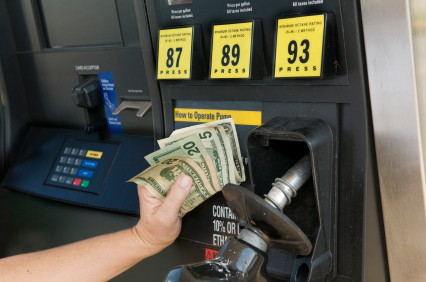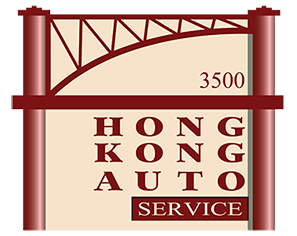Money Maker: 10 ways to save gas with vehicle maintenance
 With gas prices climbing steadily, it’s easy to feel powerless at the pump. But we’re here to show you how to save real dollars—not pennies—by keeping on top of these fuel-robbing basic maintenance items:
With gas prices climbing steadily, it’s easy to feel powerless at the pump. But we’re here to show you how to save real dollars—not pennies—by keeping on top of these fuel-robbing basic maintenance items:
Time for a tune-up?
Worn spark plugs, plug wires, and other faulty ignition parts reduce your car’s ability to clean and completely ignite the fuel in the engine cylinders. This gobbles up extra gas and can keep your car from accelerating as smoothly and efficiently as it should.
Tire talk
Tires that are underinflated will cost you 0.3 to 2 mpg because they keep the car from rolling down the roadway as easily as it should. Inflate your tires to the manufacturer’s specs in the driver’s manual, on the door label or in the glove box label. The psi on the tire itself indicates maximum tire pressure. Ignore this and use the vehicle-specific recommendations. You tire pressure will change more than 1/2 a pound for every 10 degrees the ambient air temperature changes. As we all know, Chicago temperatures can increase–and decrease–dramatically in within a few short hours.
(Note: Do not be tempted to save more by overinflating your tires! We actually saw this terrible bit piece of advice on another web site. You’ll wear out the middle treads of your tires prematurely, and in the meantime, you’ll feel every bump in the road.)
Wiley wheel alignment
Just as the engine must work harder to move underinflated tires down the highway, extra friction is created when one or more of the wheels are incorrectly angled as you speed along. They fight to go in a direction other than straight ahead, and even if the alignment is only off slightly, the effect adds up mile after mile.
Mission: Automatic transmission
If your transmission fluid is low or dirty and contaminated, this creates extra friction in the automatic transmission, which requires more engine power to overcome. Slowly, but surely this will eat away at your fuel economy.
Brake check.
You’ll suffer a double loss if you have a parking brake that’s staying partially engaged, a brake caliper that’s not fully releasing or a similar type of brake drag. Not only will your gas mileage suffer, your brakes will wear much faster.
Finicky fuel system
The cleaner your fuel system, the more efficiently the fuel will burn. And that means more power and better fuel economy. Ask you auto repair shop if you’re due for a fuel system cleaning, including the throttle body, fuel injectors and fuel filter. Not a believer? Consider this: The average car on the road is at least 9 years old. It’s had time for dirt and rust to start accumulating in the fuel tank and throttle body and to reach the fuel injectors. The injectors are the last stop in the fuel delivery system, and it’s critical for them to be clean. They deliver a precise amount of fuel, at exactly the right time, in a particular spray pattern. If they’re dirty or clogged with debris, they just can’t perform the way they’re supposed to. Dirty fuel injectors will steal some of your car’s power and will consume excess fuel.
Let there not be light
The orange “Service Engine Soon” light is a foe of your fuel economy. The warning light is triggered when tailpipe emissions exceed specified levels, and the fuel system is almost always involved. Emissions-related issues can be real gas wasters. If the light is on, have the matter diagnosed and repaired as soon as is practical.

Secure the cap
If it’s loose, gas vapor will constantly leak out, wasting fuel. (Missing or faulty gaps allow 147 million gallons of gas to vaporize annually, according to the Car Care Council.) Leaving it loose after a fill up will often trigger the Service Engine Soon Light. In addition, air can get in and cause your oxygen sensor to read incorrectly, leading the engine control computer to increase fuel to the engine. A loose gap is likely to trigger the Service Engine Soon light, too. A worn gas cap can have the same effect. If you constantly smell gas when you walk by your tank, you might need a new gas cap.
Tire Talk Part II
When it’s time to invest in new tires, consider buying tires with lower rolling resistance. Reducing the tires’ rolling resistance by 10 percent will save 1-2 mpg, reports the Union of Concerned Scientists. Consumer Reports also predicts a 1-2 mpg savings. Many tire vendors will include this information in the tire specifications.
Viscosity curiosity
Using the incorrect engine oil grade can reduce fuel economy by 0.1 to 0.2 mpg. Your engine oil is rated on its viscosity, or resistance to flow. If you put a higher viscosity oil in your engine—such as adding a 10W-30 oil to an engine designed for 5W-30—the oil will not flow as easily through the engine and makes it more effort for the engine’s parts to move rapidly through their cycles. The engineers chose the recommended oil viscosity in your engine for a reason. Stick with it, and make sure your auto repair shop does, too.
